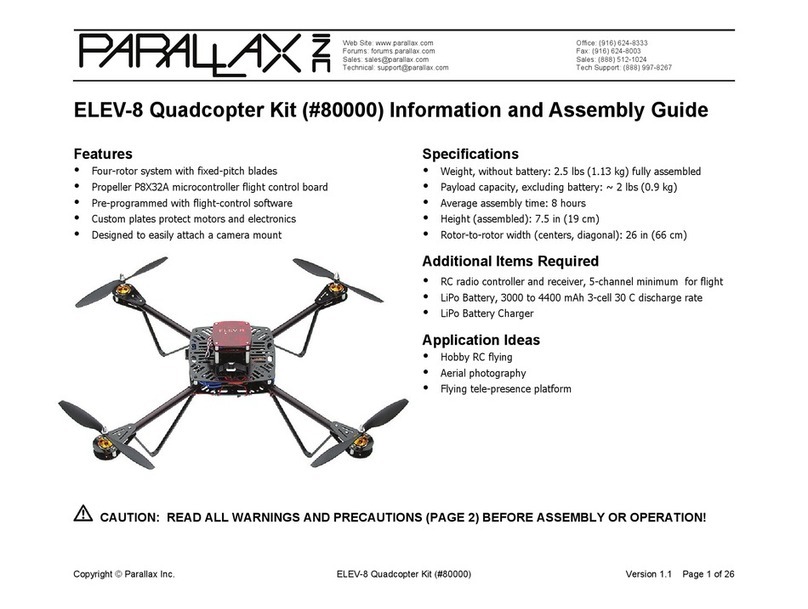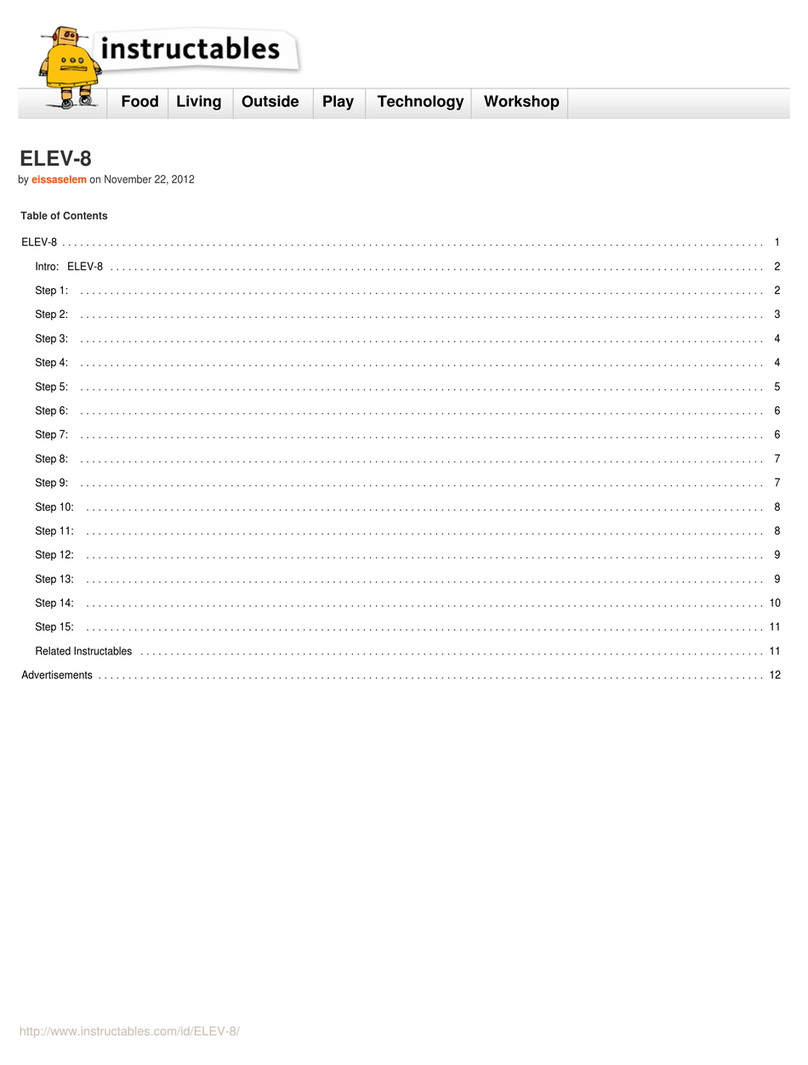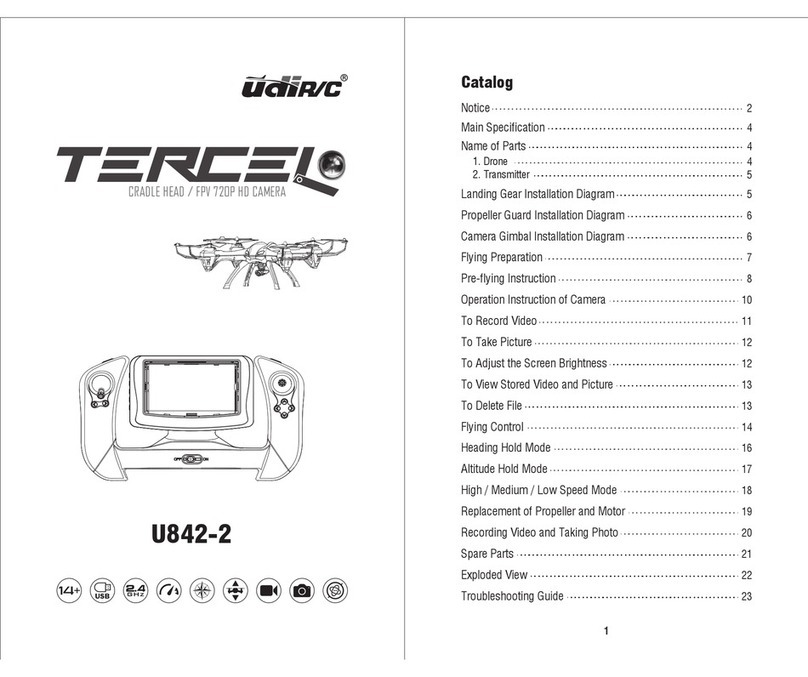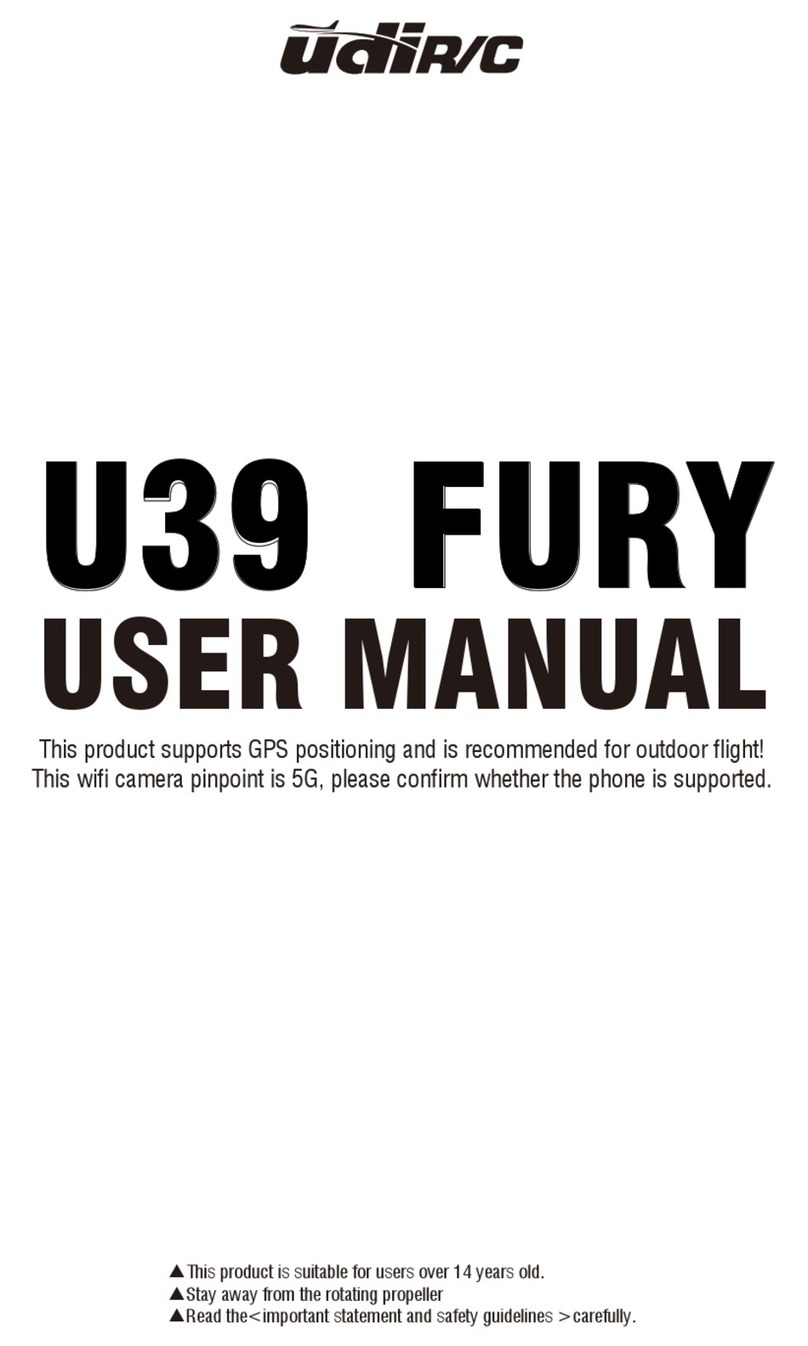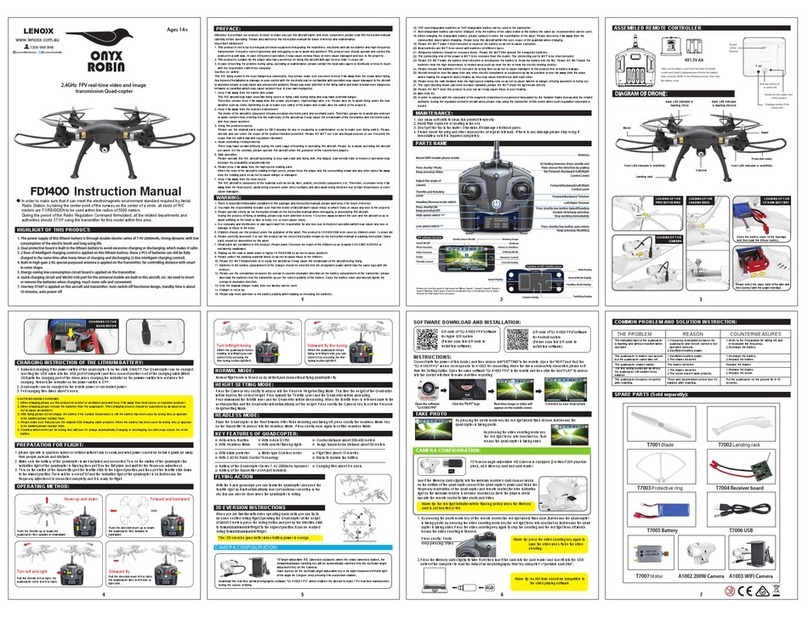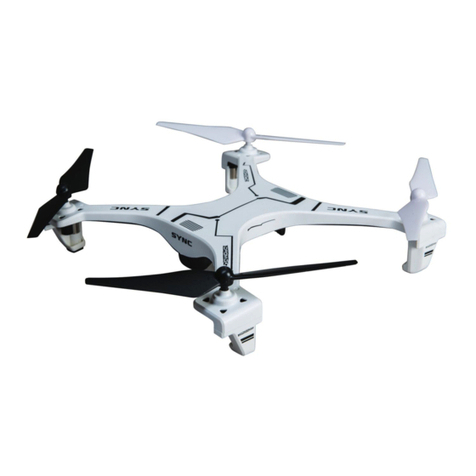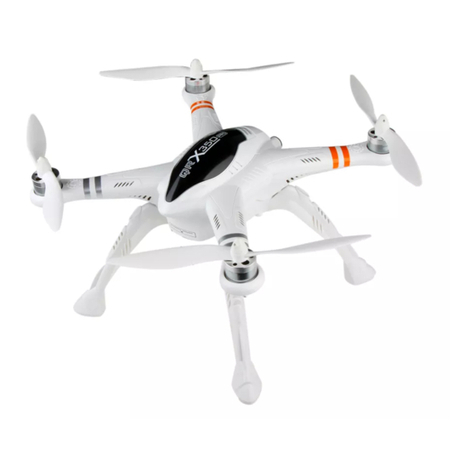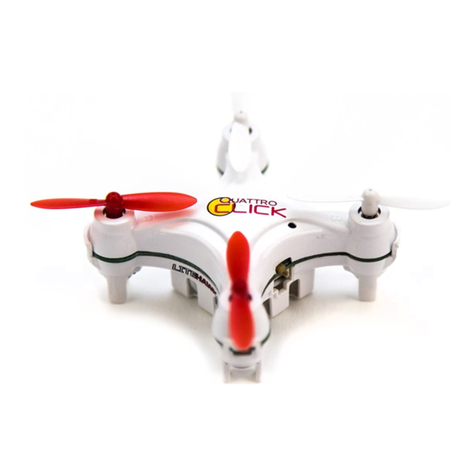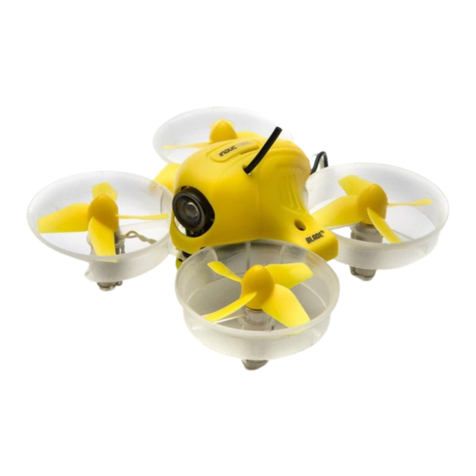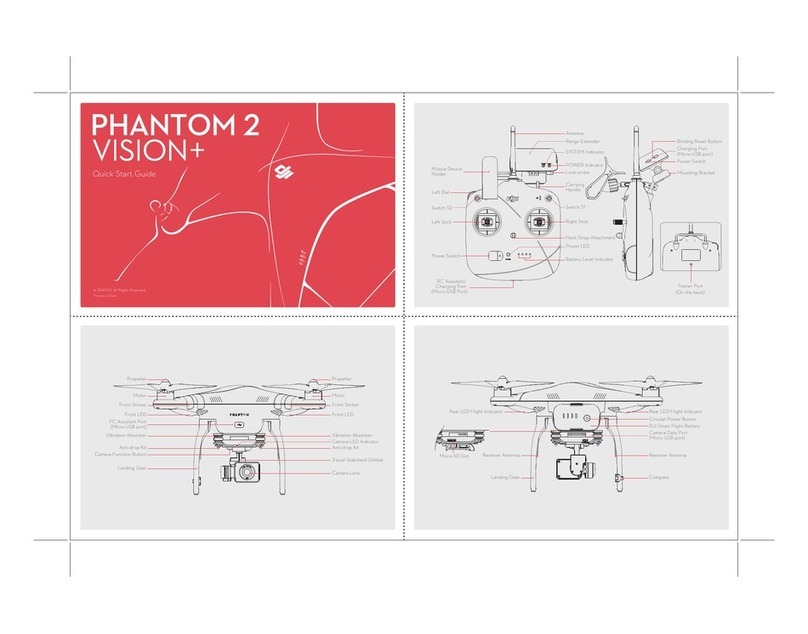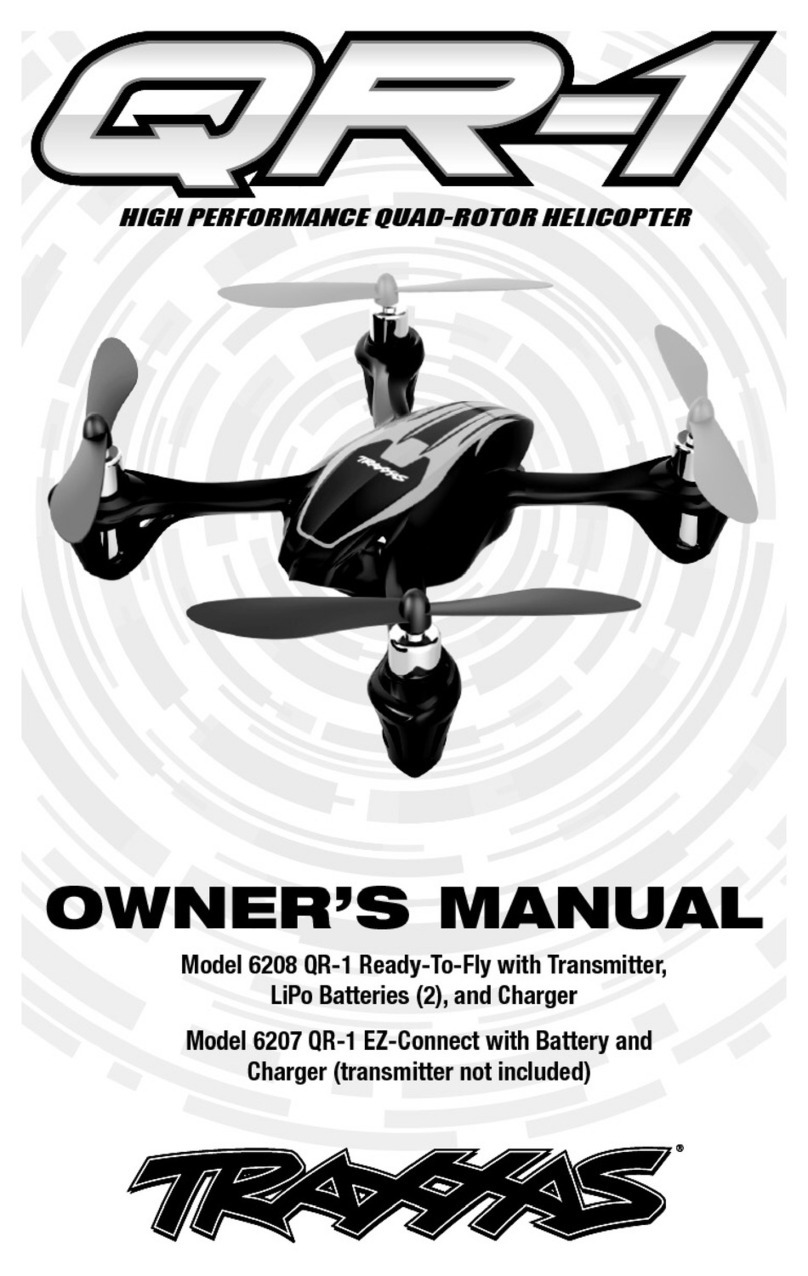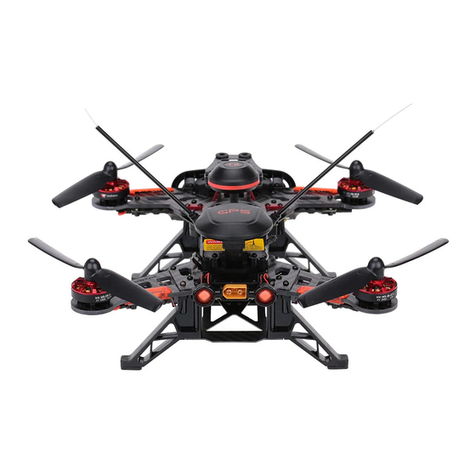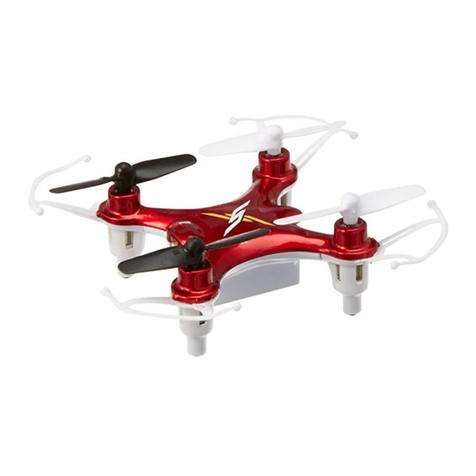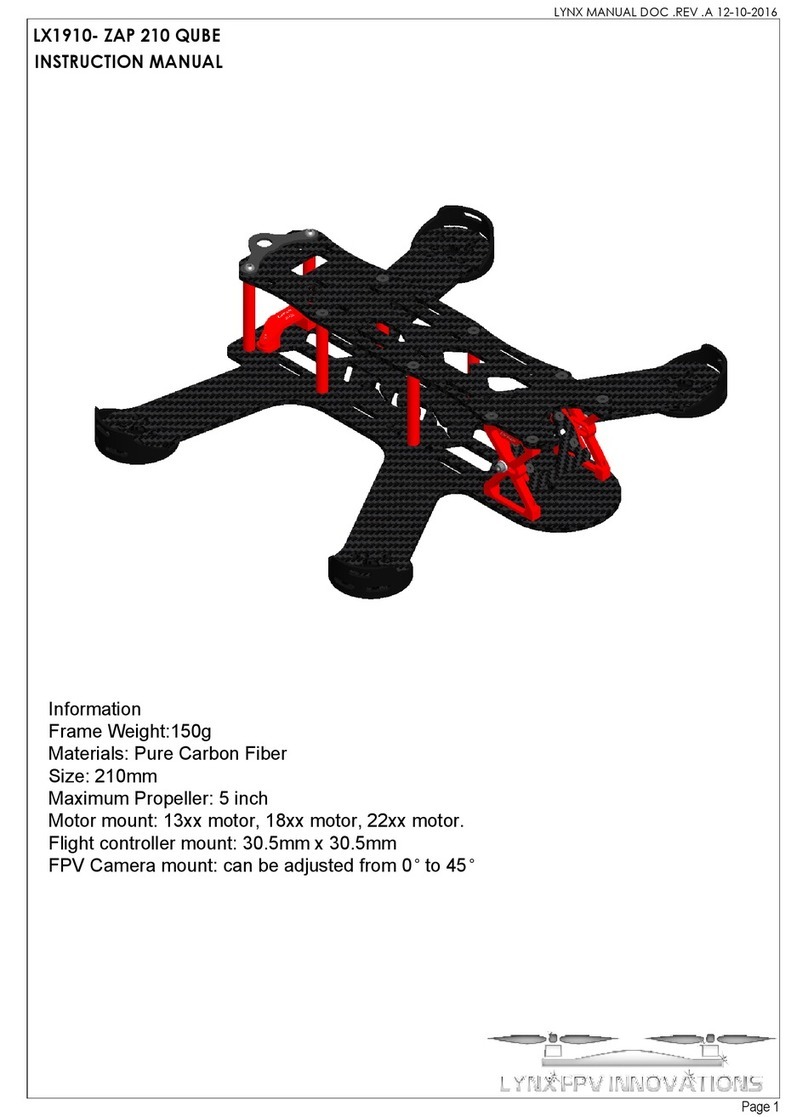Parallax ELEV-8 V2 User manual

Web Site: www.parallax.com
Learn: learn.parallax.com
Forums: forums.parallax.com
Sales: [email protected]
Technical: [email protected]
Office: (916) 624-8333
Fax: (916) 624-8003
Sales: (888) 512-1024
Tech Support: (888) 997-8267
EDU Hotline: (916) 625-6801
ELEV-8 V2 Quadcopter Assembly
Guide
Congratulations and thank you for purchasing a Parallax ELEV-8 Quadcopter, designed and
manufactured in California, USA. We at Parallax pride ourselves on producing high-quality
products with industry-leading documentation and support. These instructions are for
assembling the Parallax ELEV-8 Quadcopter Version 2 (#80200 or #80202) in its most standard
configuration.
If you have an ELEV-8 Quadcopter you must register it with the Federal Aviation
Administration's UAS Registry before flying outdoors.
Do not use any assembly instructions or guides other than those provided by Parallax Inc. for
your exact part number. Doing so may result in hardware failure and/or personal injury. Also
note that there are small but extremely important differences between Version 1 (#80000) and
Version 2 (#80200/#80202) of the ELEV-8; do not use this web guide for assembling Version 1.
This assembly guide assumes your ELEV-8 V2 kit contains a flight controller (#80200). If you
bought the ELEV-8 V2 No Flight Controller kit (#80202), sections regarding the programming
and installation of the HoverFly Open will not apply to you. Watch for special announcements
on these pages as you progress through assembly.
This guide consists of thirty-nine discrete assembly steps, organized into nine sections. The
introduction page of each section will explain what will be done in the steps within and why, and
list all of the tools and parts you will need for that particular section. If you prefer to work from a
printed version of these instructions, please be advised - this PDF assembly guide is
extremely long and will take a large amount of paper when printed.
Copyright © Parallax Inc.
ELEV-8 V2 Assembly Guide
07/26/2018

Preparation
1. Read the important Safety Information sheet included with your kit. Building a
Quadcopter is a rewarding but potentially dangerous undertaking, so it is critical that you
have an understanding of the risks involved to maximize enjoyment and minimize
danger. Please always wear eye protection when assembling, soldering, or operating
your ELEV-8.
2. Carefully cross-check the contents of your kit with the enclosed Bill of Materials (BOM). If
you are missing any components, e-mail or call our sales department (888-512-1024).
(Note: Because this product is discontinued, some parts may no longer be available.
Parallax is not responsible for replacing parts from kits purchased from a source other
than our webstore or through our sales team, or if the kit is no longer within the warranty
period.
)
3. Read the entire assembly instructions before beginning. Assembly and testing takes 6
–12 hours, depending on skill level, equipment, and work space. If you do not have prior
experience soldering, we recommend you take some time to learn and practice before
beginning this project.
4. Gather your kit and all of the additional items and tools required in a well-lit and
comfortable work area.
5. After educating yourself on the safe and proper use of Lithium-Polymer (LiPo) batteries,
charge your LiPo battery.
Please do not rush through the assembly and testing process. If you go slowly, and exactly
follow these instructions, you should experience few or no issues with your ELEV-8. But if you
accidentally overlook any part of these steps, you may end up with a dysfunctional quadcopter
that could require considerable troubleshooting before it can fly. It never hurts to double-check
your work at each step!
Copyright © Parallax Inc.
ELEV-8 V2 Assembly Guide
07/26/2018

Additional Items Required
● Radio Control Transmitter and Receiver; 5-channel minimum required for flight. We
recommend (and will provide instruction for) the Spektrum DX6i transmitter and
matching Spektrum AR610 receiver (or OrangeRX R615); this setup will accommodate
simple projects requiring one extra servo. If you anticipate building more sophisticated
projects, such as controlled camera gimbals, we recommend the Spektrum DX8 and
matching Spektrum AR8000 receiver (or OrangeRC R800X) and Spektrum TM1000
telemetry transmitter. While this equipment is somewhat expensive, it is high-quality and
will accommodate both your current and future needs.
● Lithium Polymer (LiPo) battery with 3000 to 4400 mAh capacity and minimum 20C
discharge rate, such as Parallax product #752-00010.
● “LiPo Balance Charger” (packaging should have those exact words), such as Parallax
product #752-00009. Using a charger not designed for LiPo batteries will cause the
battery to flame and release toxic smoke.
● A LiPo Low-Voltage Alarm, such as Parallax product #752-00014. These will alert you
with a very loud buzzer when your battery voltage gets low, significantly reducing the risk
of damaging your battery or crashing your ELEV-8.
We recommend you acquire the ELEV-8 Crash Pack (#80080). Crashes are an inevitable part
of the learning process, and having to wait around for replacement parts is always a bummer.
Tools Required
● Safety Eyewear (#700-10003)
● Wire Strippers/Cutters (12-16 AWG)
● Ruler or Measuring Tape
● Soldering Iron (We recommend the Parallax Basic Soldering Kit, #700-10011)
● Rosin-Core Solder, see note in Section 1 (Also in the Parallax Basic Soldering Kit)
● Work-Holding Vise (Also in the Parallax Basic Soldering Kit)
● Rosin Soldering Flux Paste (optional
)
● Metal or Wood Block with 5/32” (4 mm) hole (optional)
● Electrical Tape or Heat-Shrink Tubing
● Heat Gun, Hair Dryer, or Soldering Iron
● Small Flat-Head Screwdriver
● #1 Philips Head Screwdriver
● Pencil
● Permanent Marker
● Scissors
● 1/4” Wrench, 1/4" Socket, or Adjustable Wrench
● Diagonal Cutters ("Dikes")
● Sharp Knife, Razor Blade, or Sandpaper (between 80 and 200 grit)
● 5/16" Wrench, 5/16" Socket, or Adjustable Wrench
Copyright © Parallax Inc.
ELEV-8 V2 Assembly Guide
07/26/2018

● Flat-Nose Pliers
Loctite and 242 are trademarks or registered trademarks of Henkel Corporation, U.S.A. Spektrum is a trademark or registered trademark of
Horizon Hobby, Inc. and Bachmann Industries, Inc. Hoverfly is a registered trademark of Hoverfly Technologies, Inc. Futaba is a registered
trademark of Futaba Denshi Kogyo Kabushiki Kaisha Corporation of Japan. Hitec is a trademark or registered trademark of Hitec RCD USA,
Inc.
Copyright © Parallax Inc.
ELEV-8 V2 Assembly Guide
07/26/2018

Section 1: Soldering the Connections
All steps in Section 1 will focus on the ELEV-8 V2 electrical connections. All of the high-current
connections between components will be made using gold-plated bullet connectors (“male” and
“female” on the left and right of the below image, respectively), which must be soldered onto the
wires and covered with heat-shrink tubing. This will ensure a reliable connection while providing
flexibility to change motor polarity and replace or upgrade components as desired.
You will have to make an educated decision on whether to use leaded vs. lead-free solder.
Traditionally, solder was composed mostly of tin and lead. As it has become known that lead is
a toxin harmful to humans (only if ingested, in any form), lead-free solder has risen in popularity.
Many people still prefer to use leaded solder for its superior ability to create strong solder joints,
while others prioritize safety over performance and choose lead-free. There is an abundance of
material available on the subject, and we suggest you conduct your own research and make
your own choice.
These six steps will take approximately 2 to 6 hours, depending on your skill level and
equipment.
Tools Needed in this Section
● Wire Strippers/Cutters (12-16 AWG)
● Ruler or Measuring Tape
● Soldering Iron
● Rosin-Core Solder
● Work-Holding Vise
Copyright © Parallax Inc.
ELEV-8 V2 Assembly Guide
07/26/2018

● Metal or Wood Block with 5/32” (4 mm) hole (optional)
● Rosin Soldering Flux Paste (optional
)
Parts Needed in this Section
● 1 – 16 AWG Silicone Wire, Blue (#750-00061)
● 4 – 1050 kV Brushless Motor and Accessories (#750-90008)
● 20 – 3.5 mm “Male” Bullet Connector (#450-00050)
● 24 – 3.5 mm “Female” Bullet Connector (#450-00050)
● 4 – 30A Electronic Speed Controller (ESC) (#750-90009)
● 1 – EC3 "Male/Female" Connector Pair (#452-00088)
● 1 – LiPo Battery (Not Included)
Copyright © Parallax Inc.
ELEV-8 V2 Assembly Guide
07/26/2018

Step 1: Prepare Extension Wires
In this step, you will cut to length and strip the Extension Wires to be used to connect the Motors
to the Electronic Speed Controllers.
Tools Needed
● Wire Strippers/Cutters (12-16 AWG)
● Ruler or Measuring Tape
Parts Needed
● 15' – 16 AWG Silicone Wire, Blue (#750-00061)
Instructions
1. Using the ruler or measuring tape and wire cutter, measure and cut 12 lengths of wire,
each 12 inches (30.5 cm) long.
2. Using the wire strippers, remove 1/8” (3 mm) of insulation from both
ends to expose the
metal wire.
Copyright © Parallax Inc.
ELEV-8 V2 Assembly Guide
07/26/2018

3. Repeat for the 11 remaining wires.
At the end of this step, you should have some extra wire. You may want to cut a few short
pieces from it and strip the ends. You can use it to practice soldering in the next step.
Copyright © Parallax Inc.
ELEV-8 V2 Assembly Guide
07/26/2018

Step 2: Soldering Motor Bullet Connectors
Over the course of the remaining Section 1 steps, you will solder all of the electrical connections
for the ELEV-8. Here, you will be soldering “male” bullet connectors to the Motors’ wire leads.
Watch the video for this assembly step on our YouTube channel
(https://www.youtube.com/watch?v=tGsjf-s-J_o) before getting started.
Warning!
Risk of severe burns. Soldering iron tips become extremely hot when used. NEVER touch the
iron tip.
Risk of lung irritation. Avoid direct inhalation of solder fumes; always solder in a
well-ventilated area.
Regardless of your choice of solder, do not eat or drink in your work area, and wash your
hands thoroughly after soldering.
Tools Needed
● Soldering Iron
● Rosin-Core Solder
● Work-Holding Vise
● Metal or Wood Block with 5/32” (4 mm) hole (optional)
● Rosin Soldering Flux Paste (optional)
Parts Needed
● 4 – 1050 kV Brushless Motor (# 750-90008)
● 12 – 3.5 mm "Male" Bullet Connectors (# 450-00050)
When you remove the motors from their packaging, keep all of the included accessories. You
will need to use the bullet connectors, heat-shrink tubing, and propeller adapters
w/screws included with each motor in later steps.
Instructions
If you have never soldered bullet connectors before, use some extra wire mentioned in the note
at the end of the previous step and a few bullet connectors to practice with (you have extra of
both).
1. Take the wire at the tip of each motor lead and twist it using your fingers to bring all of
the individual wires together.
Copyright © Parallax Inc.
ELEV-8 V2 Assembly Guide
07/26/2018

2. Clamp one of the wires into the vise so that the exposed metal wire is pointing upwards.
3. After cleaning the tip of the soldering iron, apply a small amount of solder to the tip to
"tin" it (this will provide better heat conduction from the iron to the connection).
4. Apply a small amount of solder to the tip of the wire. You want to see the wire "absorb"
the solder and become covered in a thin layer of molten solder before removing the
soldering iron. It may take some time (up to 15 seconds), but it should be clear when the
solder suddenly starts to "flow" around the tip of the wire. If you have difficulties tinning
Copyright © Parallax Inc.
ELEV-8 V2 Assembly Guide
07/26/2018

your leads, dipping your wire into rosin soldering flux paste (optional, not included) first
might make the process easier. Repeat this "tinning" process with every wire.
5. Place a Male bullet connector into the vise, with the shallow “cup” end facing up. If you
are using the block, clamp it into the vise and seat the bullet connector into the hole.
6. Hold the soldering iron to the small hole on the side of the “cup” of the bullet connector,
and apply solder slowly into the “cup” until it is half full. Put the solder down.
Copyright © Parallax Inc.
ELEV-8 V2 Assembly Guide
07/26/2018

7. Continuing to hold the soldering iron to the hole, slowly insert a Motor lead fully into the
“cup” and continue to hold the soldering iron to the hole for approximately 15 seconds.
This will help to prevent a "cold" solder joint (poor quality, where the solder has not
properly fused to both surfaces).
Copyright © Parallax Inc.
ELEV-8 V2 Assembly Guide
07/26/2018

8. Remove the soldering iron, but hold the motor lead until the solder has cooled and set,
approximately 10 seconds. A good solder joint should appear as shown in the image
below; you can always re-do a joint if you are not satisfied.
9. Repeat this process to solder a "male" bullet connector to each of the three leads on
each Motor, for a total of twelve connections.
Copyright © Parallax Inc.
ELEV-8 V2 Assembly Guide
07/26/2018

Copyright © Parallax Inc.
ELEV-8 V2 Assembly Guide
07/26/2018

Step 3: Soldering Extension Wire Bullet Connectors
You’ll be using the same soldering techniques you learned in Step 2 to solder "male" and
"female" bullet connectors to opposite ends of the extension wires.
Tools Needed
● Soldering Iron
● Rosin-Core Solder
● Work-Holding Vise
● Metal or Wood Block with 5/32” (4 mm) hole (optional)
● Rosin Soldering Flux Paste (optional)
Parts Needed
● 12 – Extension Wires, prepared in Step 2
● 12 – 3.5 mm "Male" Bullet Connectors (#450-00050)
● 12 – 3.5 mm "Female" Bullet Connectors (#450-00050)
Instructions
1. Prepare the wires for soldering by twisting and tinning them. (same procedure as in Step
2)
a. Take the wire at the end of each wire and twist it using your fingers to bring all of
the individual wires together.
b. Clamp one of the wires into the vise so that the exposed metal wire is pointing
upwards.
c. After cleaning the tip of the soldering iron, apply a small amount of solder to the
tip to "tin" it (this will provide better heat conduction from the iron to the
connection).
d. Apply a small amount of solder to the tip of the wire. You want to see the wire
"absorb" the solder and become covered in a thin layer of molten solder before
removing the soldering iron. It may take some time (up to 15 seconds), but it
should be clear when the solder suddenly starts to "flow" around the tip of the
wire. If you have difficulties tinning your leads, dipping your wire into rosin
soldering flux paste (optional, not included) first might make the process easier.
e. Repeat this process with every wire.
2. Solder a "male" bullet connector to one
end of each of the twelve extension wires (same
procedure as in Step 2);
a. Place a bullet connector into the vise, with the shallow “cup” end facing up. If you
are using the block, clamp it into the vise and seat the bullet connector into the
hole.
Copyright © Parallax Inc.
ELEV-8 V2 Assembly Guide
07/26/2018

b. Hold the soldering iron to the small hole on the side of the “cup” of the bullet
connector, and apply solder slowly into the “cup” until it is half full. Put the solder
down.
c. Continuing to hold the soldering iron to the hole, slowly insert the end of an
extension wire fully into the “cup” and continue to hold the soldering iron to the
hole for approximately 15 seconds. This will help to prevent a "cold" solder joint
(poor quality, where the solder has not properly fused to both surfaces).
d. Remove the soldering iron, but hold the motor lead until the solder has cooled
and set, approximately 10 seconds.
3. Solder a "female" bullet connector to the other end of each of the twelve extension wires,
using the same procedure.
Copyright © Parallax Inc.
ELEV-8 V2 Assembly Guide
07/26/2018

Step 4: Soldering ESC Bullet Connectors
In this step, you’ll again be using the same soldering techniques you learned in Step 2, but this
time to solder "male" and "female" bullet connectors to opposite ends of the ESCs.
Tools Needed
● Soldering Iron
● Rosin-Core Solder
● Work-Holding Vise
● Metal or Wood Block with 5/32” (4 mm) hole (optional)
● Rosin Soldering Flux Paste (optional)
Parts Needed
● 4 – 30A Electronic Speed Controller (ESC) (#750-90009)
● 8 – 3.5 mm "Male" Bullet Connectors (#450-00050)
● 12 – 3.5 mm "Female" Bullet Connectors (#450-00050)
Instructions
1. Prepare the wires for soldering by twisting and tinning them. (same procedure as in Step
2)
a. Take the wire at the end of each wire and twist it using your fingers to bring all of
the individual wires together.
b. Clamp one of the wires into the vise so that the exposed metal wire is pointing
upwards.
c. After cleaning the tip of the soldering iron, apply a small amount of solder to the
tip to "tin" it (this will provide better heat conduction from the iron to the
connection).
d. Apply a small amount of solder to the tip of the wire. You want to see the wire
"absorb" the solder and become covered in a thin layer of molten solder before
removing the soldering iron. It may take some time (up to 15 seconds), but it
should be clear when the solder suddenly starts to "flow" around the tip of the
wire. If you have difficulties tinning your leads, dipping your wire into rosin
soldering flux paste (optional, not included) first might make the process easier.
e. Repeat this process with every wire.
2. Solder "male" bullet connectors to the red and black input leads on each ESC (same
procedure as in Step 2);
a. Place a bullet connector into the vise, with the shallow “cup” end facing up. If you
are using the block, clamp it into the vise and seat the bullet connector into the
hole.
Copyright © Parallax Inc.
ELEV-8 V2 Assembly Guide
07/26/2018

b. Hold the soldering iron to the small hole on the side of the “cup” of the bullet
connector, and apply solder slowly into the “cup” until it is half full. Put the solder
down.
c. Continuing to hold the soldering iron to the hole, slowly insert the end of an input
lead into the “cup” and continue to hold the soldering iron to the hole for
approximately 15 seconds. This will help to prevent a "cold" solder joint (poor
quality, where the solder has not properly fused to both surfaces).
d. Remove the soldering iron, but hold the motor lead until the solder has cooled
and set, approximately 10 seconds.
3. Solder "female" bullet connectors to the to the blue output leads on each ESC, using the
same procedure.
Copyright © Parallax Inc.
ELEV-8 V2 Assembly Guide
07/26/2018

Copyright © Parallax Inc.
ELEV-8 V2 Assembly Guide
07/26/2018

Step 5: Soldering Power Breakout EC3 Connector
The last of the soldering for ELEV-8 assembly is soldering EC3 connectors (image below) to the
Power Breakout Cable (this Step) and battery leads (Step 6). This is one of the most difficult
assembly steps, so we strongly suggest you take your time and do some research of your own
(watch some videos on "soldering EC3 connectors", etc).
An EC3 Connector presents an issue when trying to identify the "gender" of each side of the
connection. The housing at left in the above image is inserted into the housing on the right, so
one would be inclined to call the left housing "male" and the right housing "female". However,
the housing at left is for "female" contacts (bullet connectors) and the housing at right is for
"male" contacts. Since the gender of a plug is defined by the gender of the contacts, the plug to
the left is "female" and to the right is "male."
Tools Needed
● Wire Strippers/Cutters (12-16 AWG)
● Ruler or Measuring Tape
● Soldering Iron
● Rosin-Core Solder
● Work-Holding Vise
● Metal or Wood Block with 5/32” (4 mm) hole (optional
)
● Rosin Soldering Flux Paste (optional
)
● Small Flat-Head Screwdriver
● Flat-Nose Pliers
Parts Needed
● 1 - Power Breakout Cable (#800-00006)
● 1 – "Male"/"Female" EC3 pair w/cover and bullet connectors (not interchangeable with
other bullet connectors) (#452-00088)
Copyright © Parallax Inc.
ELEV-8 V2 Assembly Guide
07/26/2018
Other manuals for ELEV-8 V2
1
Table of contents
Other Parallax Quadcopter manuals

